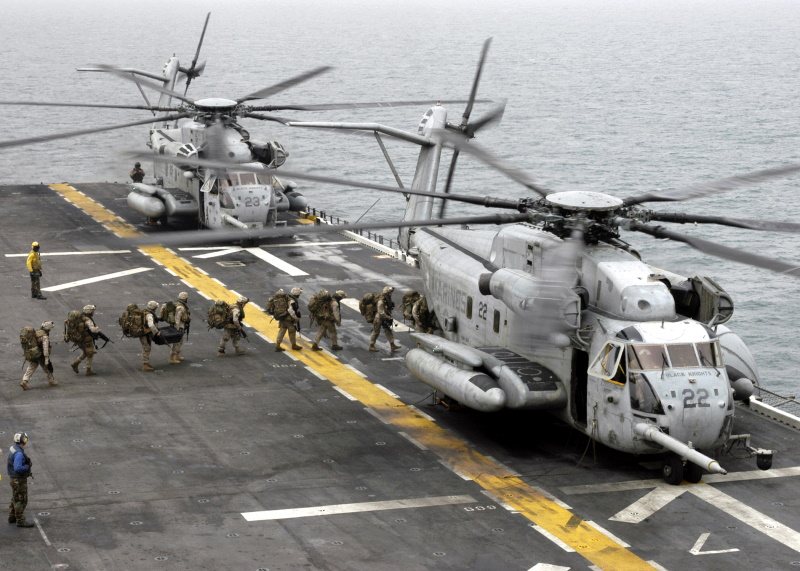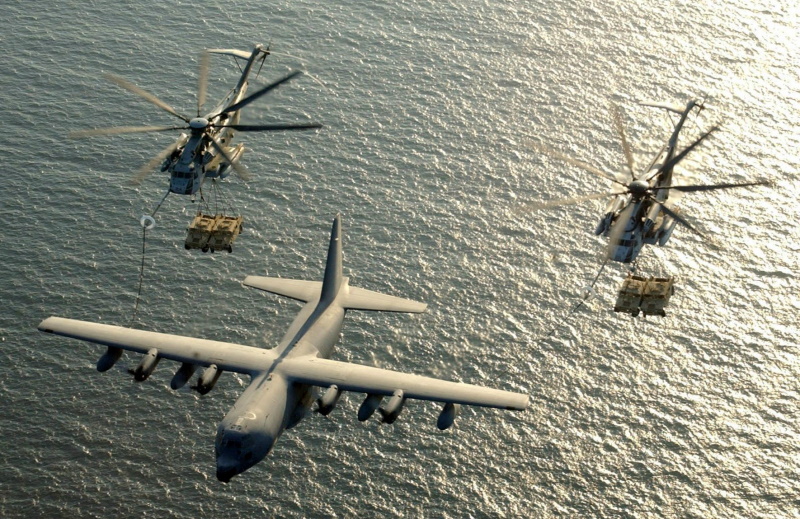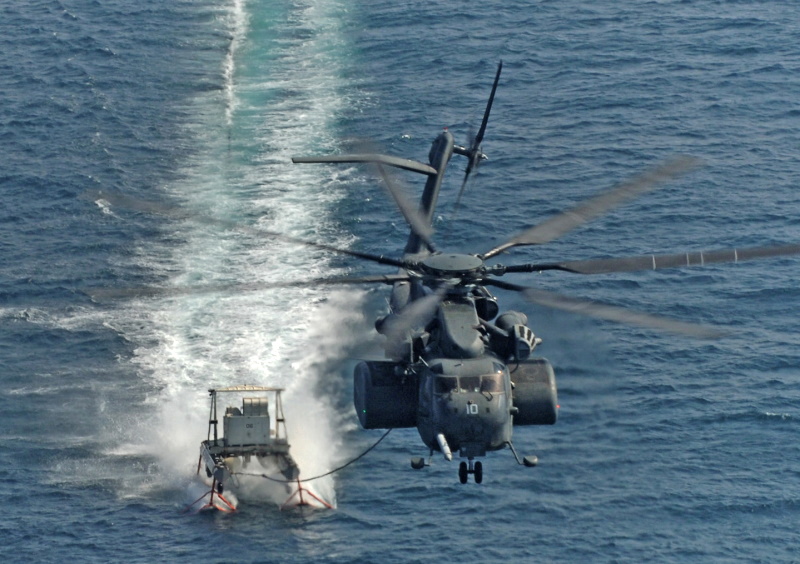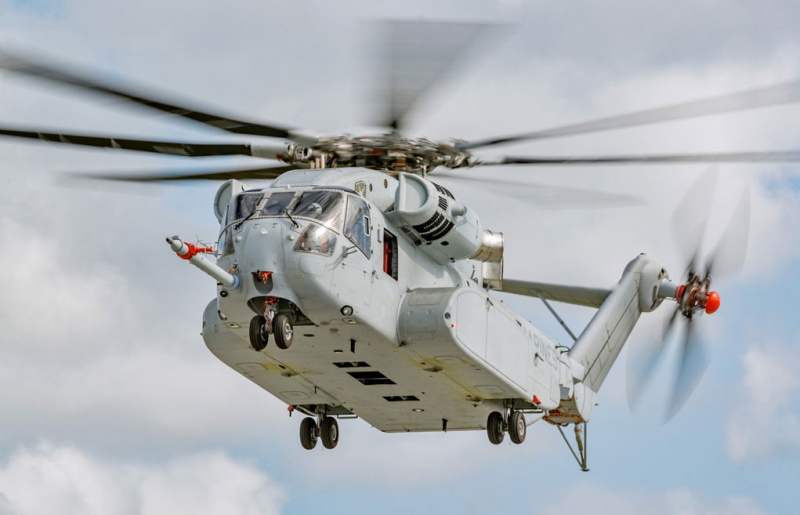
* The success of the twin-engine S-65 led to consideration of a derivative with three engines, which emerged as the "S-80". It was also very successful, and remains in production in the 21st century.
* Although the S-65 proved a better solution to military needs than the S-64, the S-65 still lacked adequate lifting power for really satisfactory use as a flying crane. Lifting aircraft could be troublesome, and it didn't have as much power as desired for the minesweeping role. Towing a sled could be troublesome, particularly through rough seas.
In October 1967, the Marines issued a Specific Operational Requirement (SOR-14-20) for a helicopter with a lifting capacity 1.8 times that of the S-65 that could still fit on amphibious assault vessels. The Navy was also interested in such a machine for the "vertical replenishment (vertrep)" role, to resupply ships at sea by air. At roughly the same time, the Army began looking for a "Heavy Lift Helicopter (HLH)" to replace the CH-54.
Sikorsky had been working on an enhancement to the S-65, which acquired the company designation of "S-80", even before issue of the requirement, with this configuration featuring a third turboshaft engine and a more powerful rotor system, and proposed this solution to the USMC in 1968. The Marines liked the idea, since it promised to deliver a good solution with a minimum of delay, and funded development of a testbed machine for evaluating the more powerful rotor system.
The Army was working on their HLH in parallel, focusing on a Boeing Vertol proposal that was something like a scaled-up Chinook. There was political pressure for all three services to obtain a common solution. In September 1970, US Defense Secretary Melvin Laird dictated that the services would all acquire the Army HLH candidate -- but the Marines and Navy protested that the giant Army HLH was simply too big to operate off of landing ships. That was obviously true on the face of it, and so at the end of 1971, Congress gave the Marines and the Navy the approval to go their own way and acquire the Sikorsky proposal; a contract for two "YCH-53E" prototypes was quickly issued. The Army HLH would be axed in late 1974.
* The first of the two YCH-53Es performed its initial flight from the Sikorsky plant in Stratford on 1 March 1974. The airframe was basically that of the S-65, but with three T64-GE-415 turboshafts, the third engine being nested on the back of the machine behind the rotor shaft, the engine intake sitting to the left of the rotor shaft. The engines featured anti-icing systems, and a Solar gas-turbine auxiliary power unit (APU) was fitted between the forward engine inlets for engine starting and ground power. It is unclear if S-65s had an APU as well. The S-80 also featured:
The S-80 could carry up to 55 troops, though it was generally assigned the heavy cargolifting role. It had an internal cargo capacity of 13,610 kilograms (30,000 pounds), and a sling load capacity of 16,330 kilograms (36,000 pounds). Sling loads could be carried by either the traditional single center-mounted cargo hook, or by a new twin cargo hook arrangement, with a hook fore and aft.

The first prototype was wrecked in a ground accident. Although the prototypes were built with a wide-span, low-mounted symmetrical tailfin, flight control problems led to refitting the second machine with of a distinctive new tail assembly, with the tailfin canted to the left by 20 degrees, and an inverted-gull asymmetric tailplane mounted on the right. This change was used in production S-80s.
The initial preproduction "CH-53E Super Stallion" flew on 8 December 1975. This was the first machine in the S-65 / S-80 series to feature a digital instead of analog flight control system; the digital system would be used in all following S-80s. The initial production contract was awarded in 1978, with service introduction following in February 1981. The USMC built up inventory of the machine and found it very useful for aircraft recovery, as well as transport of artillery, light armored vehicles, and the like.
Despite its size, thanks to its excess of power the CH-53E's speed and agility were regarded as outstanding. The digital flight control system prevented the pilot from overstressing the machine. The CH-53E provided excellent service during the Gulf War. The US Navy also liked the CH-53E and acquired it in small numbers for shipboard resupply. The Marines and Navy acquired 177 S-80s between them.
___________________________________________________________________
SIKORSKY S-80 / CH-53E SUPER STALLION:
___________________________________________________________________
main rotor diameter:
24.08 meters (79 feet)
tail rotor diameter:
6.10 meters (20 feet)
fuselage length:
22.35 meters (73 feet 4 inches)
footprint length:
30.19 meters (99 feet)
folded length:
18.44 meters (60 feet 6 inches)
height (tail rotor):
8.66 meters (28 feet 5 inches)
height (rotor head):
5.32 meters (17 feet 6 inches)
empty weight:
15,070 kilograms (33,225 pounds)
max loaded weight:
31,640 kilograms (73,500 pounds)
maximum speed:
315 KPH (195 MPH / 170 KT)
service ceiling:
5,640 meters (18,500 feet)
ferry range:
2,075 kilometers (1,290 MI / 1,120 NMI)
___________________________________________________________________
CH-53Es could carry twin-gun armament and were fitted with the AN/ALE-39 chaff-flare dispensers, just as with the RH-53D. Most or all CH-53Es were later refitted with cockpit lighting for NVG compatibility; a Hughes AN/AAQ-16 FLIR AKA "Helicopter Night Vision System (HNVS)", on a somewhat "tacked-on" mount on the left side of the nose; new radios and a GPS receiver; and pilot seats with improved crash protection. Interestingly, apparently CH-53Es were evaluated with air-to-air missiles (AAM) for self-defense, with one Sidewinder or two Stinger AAMs carried at the end of each sponson. Details of the evaluation are unclear, and this fit has apparently never been used operationally.

The CH-53E has been heavily tasked in recent years, with helicopters in the fleet starting to time out on airframe life from 2011. Machines retired by the Navy have been refurbished for Marine use, with an overhaul program for the fleet begun in 2016; but the type is in need of replacement, a matter discussed later.
* The Navy was very interested in the S-80 for the AMCM role, and acquired a variant optimized for that task, designated the "S-80M" or "MH-53E Sea Dragon". It differed from the CH-53E most visibly in having absurdly enlarged sponsons to provide substantially greater fuel storage and endurance. It also retained the inflight refueling probe of the CH-53E, and could be fitted with up to seven 1,136-liter (300 US gallon) ferry tanks internally, though it couldn't carry external tanks.
The MH-53E digital flight-control system included features specifically designed to help tow minesweeping gear. The Sea Dragon was equipped with mine countermeasures systems like those of the RH-53D, including the twin machine guns, with modern additions such as the AN/ALQ-160 acoustic countermeasures system; an AN/ALQ-166 magnetic mine hydrofoil sled; and a Northrop Airborne Laser Radar Mine Sensor (ALARMS).
The initial "YMH-53E" prototype was a conversion of a pre-production CH-53E, without the oversized sponsons, and performed its first flight on 23 December 1981. The first pre-production machine performed its initial flight on 1 September 1983, with service deliveries beginning in June 1986 and service introduction in April 1988. The Navy obtained a total of 46 Sea Dragons, with these machines operating almost exclusively in the AMCM role, since the Navy had acquired CH-53Es for the transport role. Most or all of the surviving RH-53Ds were also converted back to the transport role.

There was a plan at one time to acquire six S-80s as VIP transports for the Presidential flight, with these machines to be designated "VH-53F". However, the contract was canceled, and no VH-53Fs were ever built.
* Although Sikorsky promoted an "S-80E" export variant of the CH-53E, the "S-80M-1" export variant of the MH-53E was the only variant of the S-80 series that found a foreign buyer, with 11 obtained by the Japanese Maritime Self-Defense Force (JMSDF). The initial buy was ordered in 1983, but due to political problems the first one was not delivered until 1989. The Japanese Sea Dragons were very similar to their US Navy equivalents, but lacked the inflight refueling probe.
The Japanese Sea Dragons had a secondary transport capability and could be assigned to disaster-relief missions, a high priority for the Self-Defense Forces. The JMSDF retired their Sea Dragons in 2017, with the US Navy obtaining six of them as spares hulks. They were replaced in the mine-hunting role by the Leonardo MCM-101 Merlin.
BACK_TO_TOP* The US Marines obtained improved armament for their CH-53Es, purchasing a quantity of M3M GAU-21 12.7-millimeter machine guns from FN Herstal of Belgium. The GAU-21 can fire all available 12.7-millimeter ammunition, while offering a higher rate of fire and greater reliability than the venerable Browning M2. The Marines have plans to use the M3M GAU-21 on their other helicopters. In another upgrade program, Marine CH-53Es are being fitted with an AN/AAQ-29A FLIR imager with three levels of zoom magnification, for use in piloting at night or in bad weather.
Nonetheless, the CH-53Es are wearing out and becoming maintenance hogs. The Marines had been planning to upgrade most of them to keep them in service, but this plan stalled. Sikorsky then proposed a new version, originally the "CH-53X", and in early 2006, the USMC signed a contract for 156 machines as the "CH-53K", with the order later expanded to 200 helicopters. Five CH-53K prototypes, including a ground-test machine, were built, with initial flight of the first prototype on 27 October 2015, followed by the second on 14 March 2016. Production was initiated in 2017, with two pre-production machines built, initial deliveries to the Marines for operational evaluation in 2018, low-rate production from 2019, and first deliveries of service machines in 2021.
As introduced, the CH-53K -- named the "King Stallion" -- was a "clean-sheet" redesign of the S80. The main improvements were new engines, cockpit layout, and an airframe made mostly of composites. The engines were GE38-1B / T408-GE-400 turboshafts providing 5,595 kW (7,500 SHP) each; they were somewhat lighter than the T64s they replaced, but over 50% more powerful, had less than half as many parts, and improved fuel economy by a fifth.
The new engines dictated design modifications of the helicopter's intakes and exhaust, and were complemented by a new rotor system. The CH-53K featured composite blades with wider span than those of the CH-53E and 12% more area, the blades having swept, drooped tips, and connected to an elastomeric hub. The end result was much-improved "hot & high" performance.
The new cockpit was based on the "Joint Interoperable Cockpit", which defined a digital "glass" cockpit scheme like that of the Bell UH-1Y Huey, also flown by the Marines. The digital cockpit was complemented by a triple-redundant fly-by-wire flight control system. It also had a "health & usage monitoring system (HUMS)", derived from one such implemented for the Sikorsky S-92 helicopter.
Other changes for the CH-53K included an improved external cargo handling system and improvements to extend service life. The CH-53K is more economical to operate than the CH-53E, as well easier to maintain and service; it had over twice the radius of action and lift capacity -- 12.25 tonnes (13.5 tons).
___________________________________________________________________
SIKORSKY CH-53K:
___________________________________________________________________
main rotor diameter:
24.08 meters (79 feet)
tail rotor diameter:
6.10 meters (20 feet)
fuselage length:
22.29 meters (73 feet 1 inch)
footprint length:
30.19 meters (99 feet)
height (tail rotor):
8.66 meters (28 feet 5 inches)
max loaded weight (with sling load):
39,900 kilograms (88,000 pounds)
max loaded weight (internal load only):
33,600 kilograms (70,000 pounds)
maximum cruise speed:
315 KPH (195 MPH / 170 KT)
service ceiling:
4,880 meters (16,000 feet)
hover ceiling (out of ground effect):
970 meters (3,180 feet)
loaded mission radius:
370 kilometers (230 MI / 200 NMI)
___________________________________________________________________
The CH-53K could carry two Humvee or similar tactical vehicles, or a single light armored vehicle, as sling loads. It had a cargo hold 30 centimeters (a foot) wider than the CH-53E's to allow it to carry a Humvee internally, or standard-sized USAF 463L pallets as used on the C-17 transport; neither could fit inside a CH-53E. The CH-53K could also be used as a ground refueling tanker, being fitted with three fuel tanks of 3,030 liters (800 US gallons) each. However, the CH-53K featured new composite sponsons -- taller and longer than those of the MH-53E, but shorter in span -- to cut overall width by 1.83 meters (6 feet), giving the machine a narrower footprint for shipboard operations.

The CH-53K was fitted with defensive countermeasures and armor; it could mount a GAU-21 machine gun, or the like, on each side and in the rear. Standard personnel load was 33 troops, or 55 if center seating is installed, the seats being crashworthy. The Israelis committed to obtaining the CH-53K in 2021, to replace their S-65s; the initial buy was 12 machines, with deliveries from 2026. The Germans also considered it, but decided to obtain the Boeing CH-47 for NATO compatibility.
BACK_TO_TOP* The following list gives the types and numbers of Sikorsky giant helicopter variants:
The next-generation CH-53K / S-80 is only now going into production, and so is not yet included in this listed.
BACK_TO_TOP* As is so often the case, I thought this would be a fairly straightforward writeup, and it turned out to be about twice as long as I expected it to be.
I can only recall seeing an S-65 once, or at least I think it was an S-65. I was down at Fort Hood, Texas, in 1973 and 1974, and was wandering around on the post when I got to witness a huge helicopter taking off. I wasn't that familiar with the Sikorsky family at the time and all I knew was that it was a Sikorsky Green Giant of some sort, but though the memory is vague I don't think it was an S-61R. I do remember the awesome threshing of its big main rotor.
I've much more recently seen an Erickson S-64F being prepped for fire fighting operations in Montana, and also had one fly over my house at night in fire season, tanking up water from a nearby small lake. Incidentally, those readers who took notice of the term "gremlin nest" in the text should be aware that this is not military slang -- it's my own little phrase.
* Sources include:
* Illustrations details:
* Revision history:
v1.0.0 / 01 jun 04 v1.0.1 / 01 may 06 / CH-53K. v1.0.2 / 01 mar 08 / Review & polish. v1.0.3 / 01 apr 09 / Review & polish. v1.1.0 / 01 dec 09 / Went to two chapters, added corrections. v1.1.1 / 01 may 10 / Review & polish. v1.1.2 / 01 mar 12 / Review & polish. v1.1.3 / 01 feb 14 / CH-53K status updates, CH-53D retirement. v1.1.4 / 01 jan 16 / Review & polish. v1.1.5 / 01 dec 17 / Review & polish. v1.1.6 / 01 nov 19 / Review & polish. v1.2.0 / 01 sep 21 / Review & polish. v1.2.1 / 01 aug 22 / Review & polish. v1.2.2 / 01 may 24 / Review & polish.BACK_TO_TOP
